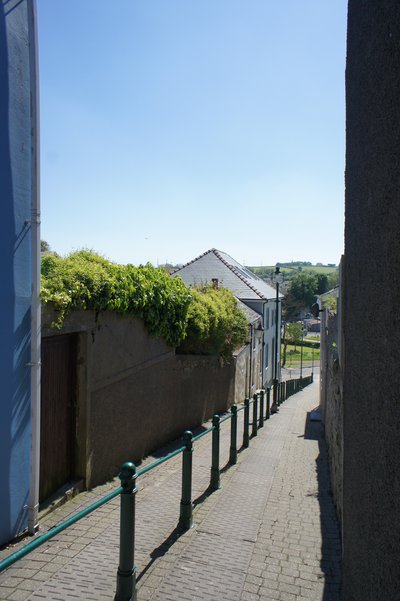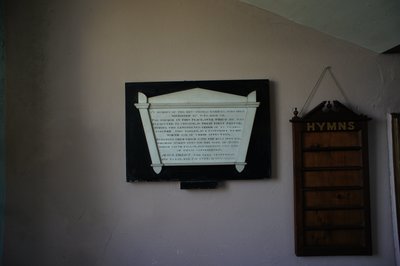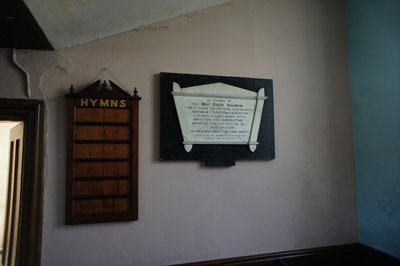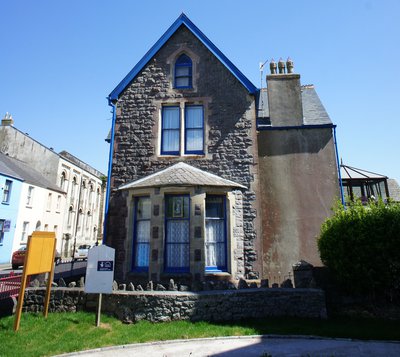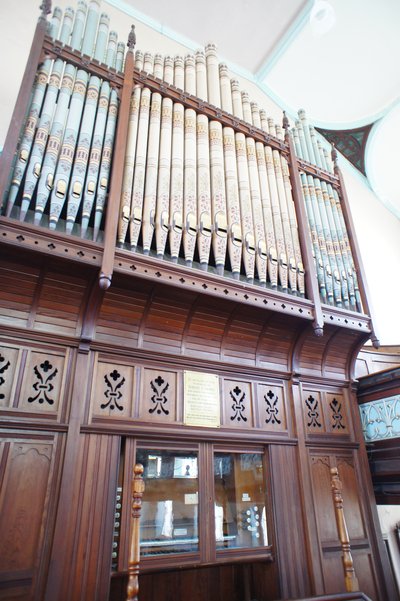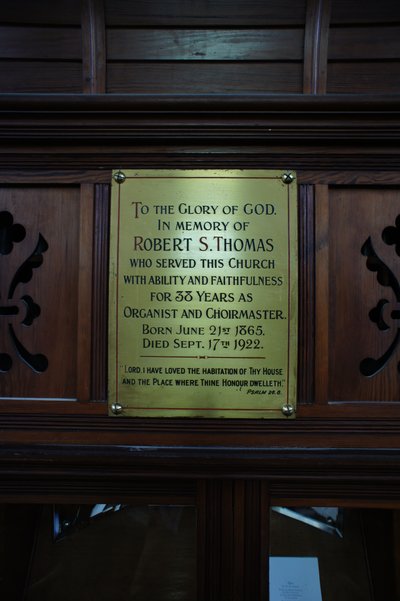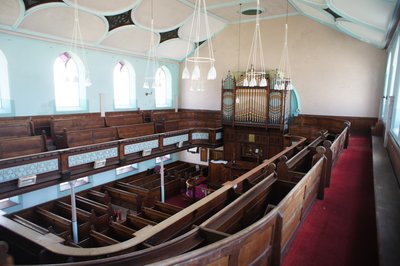A Detailed History of the Tabernacle Church in Pembroke
This complete history of the Tabernacle URC was written by Jonathan E Harries in 2011. It gives the full story of the church from its origins in the year 1800 to the present day.
The religious needs of the citizens of Pembroke have been well served almost from the town’s foundation, the town being split into two parishes each containing fine Norman churches. Additional places of worship were founded during the 19th century with four non conformist churches being built in Main Street alone. One of these, the Tabernacle, stands back from the road, its many windowed structure and spire visible across much of the town. The Tabernacle displays a proud stone scroll stating 1811 to 1867, a slightly misleading and long outdated statement.
The church’s history starts in the year 1800 when two Congregationalist preachers from Carmarthenshire, Richard Morgan of Henllan and Morgan Jones of Trelech made several preaching tours through the English speaking parts of Pembrokeshire. They preached at Manorbier Newton and were successful in founding a Congregationalist society there. Long standing societies were also founded at Rosemarket, St Florence and Sardis. Joseph Thomas and William Lowless were elected elders from a membership of only a dozen or so. The society would meet in a cottage in the village and was visited by its founders from time to time; they were assisted by two North Pembrokeshire preachers, W Meyler of Rhosycaerau and W Griffiths of Glandwr. Regular visits were also made by Mr Arnold Davies of Rosemarket who was appointed by Morgan and Jones as an itinerant minster to serve the societies they had founded.
In 1802 a house was purchased in Lamphey by the growing society in Manorbier Newton and converted for public worship. Not long after the move to Lamphey Mr Arnold Davies ceased to visit the society due to the demands of his church in Rosemarket. Around this time Mr Thomas Harries moved to Pembroke. He was the son of the Rev W Harries, Congregational Minister of St Davids and Solve and educated at Wrexham College. He became a member of the society in Lamphey and its recognised minister. The membership grew to around twenty following the move to Lamphey with many people attending services from Pembroke, however few people from Lamphey attended the services held there. As the majority of the congregation came from Pembroke the society was keen to relocate there, however the challenge and cost of building a chapel dissuaded the members.
In 1811 things changed. The Rev Thomas Luke, the newly appointed minister of the Tabernacle in Haverfordwest, visited Pembroke to preach to the townspeople. He was well received, so much so that he urged the society in Lamphey to relocate to Pembroke. The Rev Luke successfully obtained a plot of land in the town on a 99 year lease for a nominal rent from Sir John Owen of Orielton on which to build a chapel and manse. This was not in the Tabernacle’s current location but at the bottom of the New Way, the building is known today as Old Chapel House. The foundation stone was laid on July 9th 1811, the official foundation date of the Tabernacle Church.
The chapel was opened for divine service on July 7th 1812 during a day of prayer and sermons. Many ministers were in attendance including the instrumental Rev Luke but the church was in the safe hands of the Rev Harries. With a new commodious chapel in the town the Rev Harries worked tirelessly for the church and during his ministry would admit over 400 members to the Tabernacle. This growth was initially aided by the foundation of the new dockyard at Paterchurch. Rev Harries soon realised that the needs of the members from Paterchurch would best be served by its own place of worship and advised members who lived there to form their own church. They were successful and a small chapel was built in the new town in Brewery Street in 1824, the congregation would ultimately go on to grow considerably and build the Tabernacle on Albion Square.
The Rev Harries was an energetic minister visiting Lawrenny, Cosheston, Stackpole, Bosherston and Castlemartin regularly to preach. He also aided one Richard Morris in the building of the Nebo branch chapel in Cosheston. His ministry ended following a period of illness in 1845 when he died at the age of 63. A memorial to him was set up on the wall of the chapel which was later moved to the new Tabernacle.
During the Rev Harries’ illness the church was served by the Rev Henry J Davies of Usk, following the Rev Harries death he became the church’s minister. He did not remain long, entering the Church of England in 1847. The church was without a permanent minister for over a year before the Rev W C Fisher was invited to become minister. His tenure was short, however he was instrumental in the building of Mains chapel in Monkton which held a small Sunday School and occasional preaching. Rev Fisher left the Tabernacle for the Church of England in 1850. The Tabernacle was again without a permanent minister until 1852 when the Rev John Cunnick took the post, again the congregation were let down when the Rev Cunnick left the church in 1857. The Rev. Benjamin Williams became minister in 1858 but again his tenure was short leaving the Church in 1862. During his ministry a harmonium was purchased for the chapel which Rev Williams’ wife would play. Despite the upheaval of this time the congregation continued to grow and the church was guided through this period by senior Deacon and local businessman William Trewent.
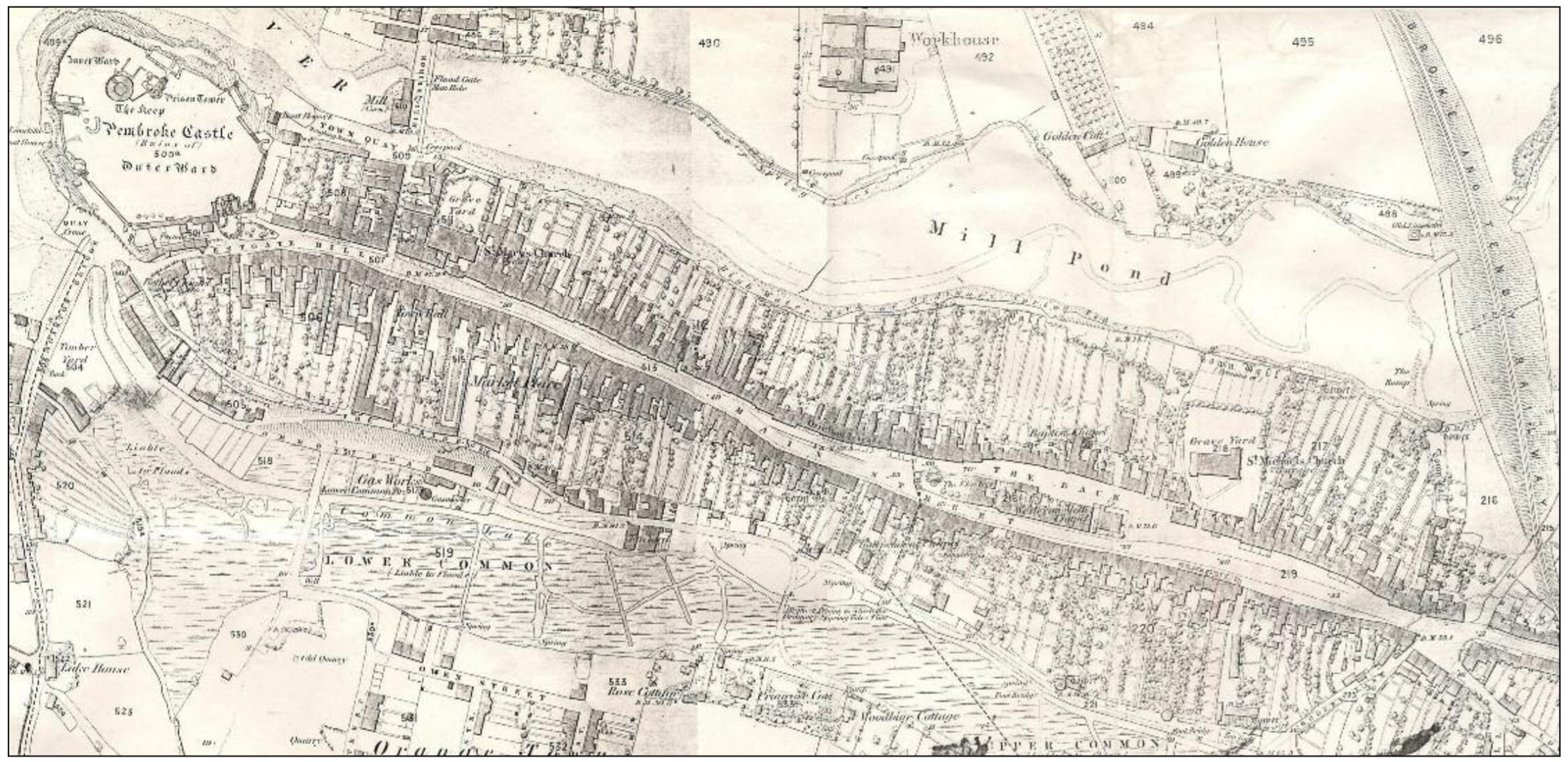
Pembroke OS First Edition 1885
In 1862 the Rev David Salmon of Trowbridge, Wiltshire became pastor of the Tabernacle. He was dedicated to his new church and decided the time was right to build a new Tabernacle as the current chapel was in need of renovation and unable to accommodate its entire congregation. A piece of land was purchased on Main Street from the Rev W Bowling, rector of Cosheston for £40. The land was occupied by three dwellings, one of which was believed to have been used as a preaching house in the eighteenth century, they were all demolished, A fund raising drive was begun; contributions were received from Samuel Morley MP and Sir Titus Salt. Both were well known industrialists and supporters of Congregationalism at the time.
The chapel was designed by the Rev Thomas Thomas of Glandwr, Swansea, the renowned minister and architect of over one hundred chapels in Wales and beyond. He already had connections with the Tabernacle, his sister margaret Simon and her family were members of the congregation, some of whom went on to become ministers themselves.
The foundation stone of the new chapel was laid on August 4th 1867 by Samuel Morley, MP for Bristol. The stone was placed on top of a sealed bottle containing coins dated 1867 and a selection of current newspapers. A series of speeches and sermons were made by local dignitaries including senior Deacon William Trewent who was Mayor of Pembroke at this time. Construction by William Allen of Pembroke Dock took just under a year with the opening of the new Tabernacle taking place on July 14th 1868. It is interesting to note that all the non conformist chapels in Pembroke were rebuilt around this time, Westgate Chapel in 1866, the Wesleyan Chapel in 1872 and Mount Pleasant in 1877 which was also designed by Thomas Thomas.
The construction of the new chapel cost £2,470 4s 4d but the congregation now had a fine new place of worship with seating for over five hundred people and additional rooms including a schoolroom beneath the chapel. The cost of constructing the chapel had resulted in a large debt which the Rev Salmon and William Trewent worked extremely hard to pay off. The sizeable new chapel allowed the congregation to grow further and several new deacons were appointed to help oversee the organization of the church.
During this time Rev Salmon’s health began to deteriorate and he died on May 26th 1877. A memorial to him was erected in the chapel he was instrumental in building.
The Rev Joseph Joseph of Hirwaun became minister later that year and in 1878 the members of the church decided to build a manse for the chapel. The cottage adjacent to the Tabernacle was purchased and the manse, also designed by the chapel’s architect Thomas Thomas was built for just over £800, Rev Joseph and his family becoming the first residents.
The Rev Joseph left the Tabernacle in 1882 for a new post in Essex. He was replaced shortly afterwards by the young preacher Howell Powell of St Ishmaels. On accepting the ministry of the Tabernacle it was discovered that the new minister was still Mr Powell, he had not yet finished the exams that would allow him to become a minister. This was addressed quickly and the now Rev Powell took up his new post. A year later Senior Deacon and former Mayor William trewent died suddenly, he had been influential in the growth of the church being a deacon for nearly forty years.
The Rev Powell continued the work of his predecessors with vigour and was dedicated to the Tabernacle. He oversaw further growth in the congregation and the renovation of the Tabernacle, the Nevo branch chapel in Cosheston and Mains Chapel in Monkton in 1889. With the hard work of the Rev Powell and the congregation the debt of the church was finally paid off in 1892. In 1898 an organ was purchased for the chapel built by Connacher and Co of Huddersfield. The organ was ably played for many years by Mr Robert S Thomas, a memorial plaque for Mr Thomas was attached to the organ following his death in 1922.
These were the “Glory Days” for the Tabernacle, when its congregation peaked. As they continued to play an important role in civic as well as religious life several Deacons became Mayor of Pembroke, including Walter Simon in 1895, Rees Phillips in 1909 and Senior Deacon John Jones in 1911.
1914 saw the beginning of the dark days of the Great War. Church records do not indicate that any of the members of the congregation died in the conflict however in March 1920 the church held a homecoming supper for all servicemen who were connected with the Tabernacle. The church did discuss fitting a memorial window at the front of the chapel to commemorate the sacrifice made by men of the town but this was not pursued. In 1920 the church was fitted with electric lighting, replacing the original gas lighting.
In 1925 the Rev Powell announced he was to retire after forty three years as pastor. The church appealed to him to reconsider but the Rev Powell’s health was failing in his old age and his resignation was reluctantly accepted. Following his farewell sermon in 1926 the congregation presented him with a generous gift of 100 Guineas.
The church spent over a year trying to find a new minister before the Rev J Cynog Hughes of Ebbw Vale was invited to the church. He had impressed the congregation during several previous visits to the church which he had preached. He was welcomed to the church in July 1928.
One of the Rev Hughes first tasks was to oversee the fitting of a new stained glass window in the front of the chapel. Mrs Elizabeth Perkins, youngest daughter of former Deacon thomas Jones had written to the church from New Zealand where she was then resident with her family. What had inspired Mrs Perkins to donate £50 to the church for the window over 50 years after her father’s death is unknown.
The church welcomed the gift and for a price of £65 a new window was fitted by Bristow Wadley of Cardiff. The memorial window to Thomas Jones remains in place until this day. 1929 was a busy year with the luxury of heating being installed in the chapel and schoolroom. In addition much needed renovation work was carried out on the Tabernacle and Mains Chapel. The cost of this work came at a bad time, by the early 1930’s the Great Depression had begun following hard on the heels of the closure of Pembroke Dockyard in 1926. Members of the congregation were generally less well off and weekly offerings had dropped by almost £30 per week. Deacons Ronald Lowless and Thomas W Colley generously contributed to church funds and many fund raising activities were held to reduce the debt the church had built up over the previous few years. By 1934 the debt has got worse, the church records show that contributions to church funds were down “owing to the present distress through unemployment in the district”. To address the financial crisis cuts were made in church expenditure including a reduction in the Minister and Caretaker’s wages until “prosperity may come to the town again”.
Just over a year later in 1935 the Rev Hughes decided to leave the Tabernacle for Manselton Church, Swansea. Whether the financial woes of the church affected the Rev Hughes decision cannot be known. Whatever the reasons for Rev Hughes departure he kept in touch with the church attending the funerals of several prominent members of the Tabernacle after his departure for Swansea.
Rev Hughes replacement in 1936 was the Rev Herbert Jones of Shrewsbury. The hardship of the depression and the closure of the Dockyard were discussed at Rev Jones induction. As well as the economic hardships suffered by the townsfolk it was also noted that many members of the congregation had left the town to work in ports such as Devenport, Chatham, Portsmouth and Gillingham. The church was encouraged by rumours that “there were according to the best authorities good prospects of the Admiralty doing something to the Dockyard”, the rumours were unfounded.
The Second World War shattered the peace of the town but provided some respite for the Dockyard as it was used as a Flying Boat station. Members of the congregation joined the armed forces and the Tabernacle itself also played its part in the war, its schoolroom being used at one point as a temporary billet for servicemen.
Following the war the already depleted congregation lost many of its senior members including its Senior Deacon and former Mayor, Councillor Thomas W Colley. His wife Elisabeth presented the church with a gift of £87 and an ornately inscribed pulpit Bible in memory of her husband, the Bible is still in use.
In 1951 the Rev Jones announced his retirement. His decision made by his wife’s failing health. For fifteen years the Rev Jones had steered the Tabernacle through difficult times and his work had been greatly appreciated. The help he gave to the poor was noted at his farewell service “no one ever called at the Manse and went away empty handed”.
Rev H Roy Hughes was the next minister at the Tabernacle. A former RAF man who had served for two years in India, he was only twenty four and married a month before his ordination. The youthful Rev Hughes was particularly keen on improving and expanding the Sunday School at the church. He was keen to retain members and stop the decline in the congregation. The closure of the Albion Square Tabernacle in Pembroke Dock in 1954 was a reminder of the fate that could befall a church in changing times. The loss of the Tabernacle’s sister church did increase the fate that could befall a church in changing times. The loss of the Tabernacle’s sister church did increase the congregation slightly as some worshippers transferred to Pembroke. The Mains Chapel in Monkton also fell out of use at this time. It had been used by local people for over 100 years and was later demolished as part of Monkton’s redevelopment. The Rev Hughes left the church for Gowerton, Swansea in 1956. Rev J J Bowen became Minister in 1957, coming to the Tabernacle from Monmouthshire. Ironically as the congregation of Rev Bowen’s new church slowly diminished and aged the financial state of the church improved. A series of generous legacies by wealthy members of the congregation were made including £500 by local business man T L Bowling in 1964. These gifts would ensure the financial security of the church for years to come. The Rev Bowen moved to London in 1965, his replacement being the Rev Thomas J Hopkins from Van Road Congregational Church, Caerphilly.
The Rev Hopkins, or “Hoppy” as he was affectionately known, would devote much of his life to serving the Tabernacle. Throughout his ministry the congregation slowly diminished despite his devotion to the church. He was the Minister when the church’s Sunday School closed in the late 1960’s, however the schoolroom would later find use as a kindergarten. Rev Hopkins also oversaw the church during its change from the Tabernacle Congregational Church to Tabernacle United reformed Church in 1972 following the union of the Presbyterian Church of England and the Congregational Union of England and Wales. He retired in 1977 but would continue to preach for many years. He also continued to live at the Manse after his retirement before moving out a few years prior to his death in 2003. The Manse was then sold and remains in private ownership.
Rev Roger Jones was minister from 1981 until 1983 and was also Minister of Trinity URC in Pembroke Dock. the church was without a dedicated minister for fourteen years following the departure of Rev Jones, preaching duties were largely performed by the Rev Hopkins and visiting ministers. In 1997 Rev Russell Gordon became minister of the tabernacle. The Rev Gordon was also Minister of the United Reform Churches in Reynalton, Templeton and Narberth. The congregations of all four churches would gather for combined services from time to time.
The Rev Nanette Lewis-Head became Minister following the departure of Rev Gordon in 2007. Rev Lewis-Head was the first female minister of the church, she retired in 2009 but still preaches occasionally at the Tabernacle. Under her leadership a new pastorate was formed in 2007 with St John’s URC/Methodist Church Tenby, Templeton URC and Reynalton URC. In September 2012 Rev Chris Tolley was called as Minister to the Pastorate, becoming the seventeenth minister to serve the Tabernacle Church. He continued as Minister until his death in 2016 after a long illness.
The congregation of the church now resembles that of its founding society, small but dedicated and without a permanent minister.
By Jonathan E Harries 2011
Related Articles
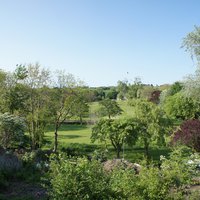
Journey Through Time Garden
The Tabernacle United Reformed Church has a unique and dramatic plot that extends down to The Commons and features medieval stone walls, a cliff, a cave, a 17th century lime kiln and stunning views across The Commons to the South ...
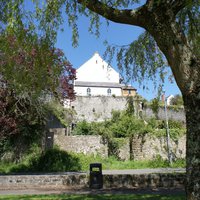
Ecology and Wildlife
The Tabernacle’s burgage plot garden has long been unused and church members were keen to create a place of peace and solitude that could be enjoyed by themselves, local people and visitors.
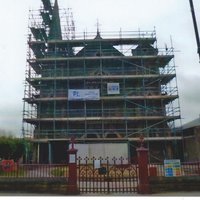
The Restoration of The Tabernacle URC
The Tabernacle buildings have received the urgent repair that they needed securing the future of the building for future generations.
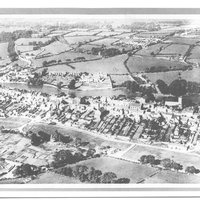
History of the Tabernacle URC
This complete history of the Tabernacle URC was written by Jonathan E Harries in 2011. It gives the full story of the church from its origins in the year 1800 to the present day.
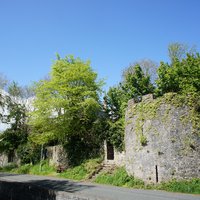
Archaeological History
The Tabernacle Church sits atop Pembroke’s limestone ridge and its burgage plot extends down to The Commons via a steeply sloping site which drops a total of 40 feet. Immediately to the south of the church is a tall ...
